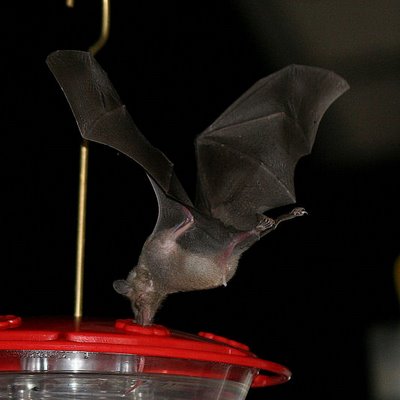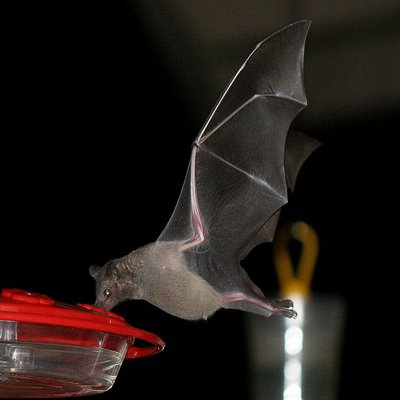Because of the intense summer heat in our area, we clean and refill our hummingbird feeders every other day, even though they usually aren’t empty unless a Gila Woodpecker has been visiting. However, during the last week or so, we’ve found our hummingbird feeders bone dry in the mornings. Our local bird seed suppliers told us the cause: nectar-feeding bats. It’s possible that during our current very wet season the bats have produced more pups than usual, which may account for their prevalence.
This evening, I thought I’d try to catch them in the act. I had a wonderful time watching them. This is my first time using a tripod and shutter cable release on my DSLR. Because I couldn’t focus well in the dim porch light, I let the camera do the focusing. This worked well enough for me to get some photos.
Look carefully at this one. See the long pointed tongue dipping into the nectar!

The bats stay only a second or two at the feeder. It's amazing to me that they can get their tongues into the feeder and take the nectar in that short a period.

There’s a delightful article on nectivorous bats written by David S. Lee and Mary K. Clark in 1993.They observed the bats visiting hummingbird feeders in the Chiricuahua Mountains of eastern Arizona. Only two species of Nectivorous bats are found in Arizona. L. curasoae, lesser long-nosed bats, are large and pale. C. mexicana, Mexican long-tongued bats, are slightly smaller and noticeably darker. I don’t know enough about bats to identify these, but they look pretty large to me. I observed their behaviour for about 90 minutes this evening. Based on the description of their behaviour in the Lee & Clark article, my guess is that they’re lesser long-nosed bats . (If anyone can identify them from my photos, please post a comment.)



18 comments:
Quelles belles photos !
Elles me font penser à des ballerines en longues jupes dansantes tournoyant pour faire voler les tissus .
beautiful bats! I do indeed see that long tounge dipping into the nectar. these close ups provide a rare look at these beauties -- very cool, Pam!
They are at my hummingbird feeders too. Last year, the bats would arrive at around 10 PM, whereas this year, larger numbers of them now arrive around 8 PM.
wow, that is a fantastic picture. Fascinating
Wow. I've seen some stuff about this in the past but your photos rule Pam!
The photos are brilliant! bats are such fascinating creatures. During the sumer months we have little pipistrelle bats flying over the garden. I love to watch but i could never get a picture.
Fantastic, beautiful, wonderful photos! Well done, Pam. I had no idea that bats went to feeders. I doubt that we have the same kind of bats up here in Ontario, but . . .
What wonderful photos!! And very pretty bats too.
I think Ontario Wanderer is right that we have no nectar-drinking bats in Ontario--just a couple of species of insectivores, I think.
Your photos are amazing, Pam! Great job on your first tripod, cable release shooting. I've never done that before, but your shots make me want to try. I'm glad you pointed out the tongue in the first shot. I probably wouldn't have seen it otherwise. Wow!
I'll have to see what kinds of bats we've got around here. I think we have 6 kinds in Vermont, but I'm not sure if any are nectar suckers. :)
These photos are amazing! Thank you for sharing them. It's so neat to see fascinating these creatures. I wouldn't have noticed the tongue either if you hadn't pointed it out. Wow, that's long!
Our bats come out after dark and clean up lots of insects...good little helpers :)
Really cool pics!
I've been watching bats flying over the neighborhhod at dusk the last few nights.
Thanks for sharing these impressive pics.
Fantastic. I'm running right out to refill my feeder in the hopes that the visitors will become more diverse.
Merci, Jean! I like very much your analogy.
tdharma - I was so excited when I saw the tongue. Lucky shot, great camera.
tbeth - I had an interesting experience last night. I took away one of the two feeders because it was empty. A bat flew in and circled and circled, but couldn't find the second feeder. They must have been homing on the pair. When I put the empty feeder back, the bats were able to find the other one with no problem and never went near the empty one. Very interesting to observe.
rain - I'm quite fascinated. I've been out every night watching them. They're so graceful in flight.
tai haku - Thank you! As I said to tdharma, they were lucky shots. Most of mine were quite blurred.
mary - We have bats continually here, but I don't remember having this experience with them before.
ow - The local wild bird place is selling extra large feeders (72 oz.) for people who are interested in feeding the bats. We're just letting them deplete the two hummingbird feeders every evening.
pamela - These are insectivores, too. They do a good job of controlling the mosquito population.
laurahinnj - Thanks for stopping by. I've always watched the bats flying high in the air, but I've never seen them close up before. They come swooping in just inches from my head.
lené - Aren't they the coolest? Not pretty in our terms, but really wonderful. I think we have three or four different kinds of bats here. I'm going to have to research them a bit more. t.beth probably knows all about them.
kerri - I love the bats and welcome them as you do. And they are certainly good natural insect exterminators.
annie elf - Thanks for visiting my blog. I hope you get some interesting night visitors, too.
Wonderful!!!
I did not think of the bats at the hummingbird feeders. I knew something was using the feeders at night... Last night I got to see a bat at the feeder. Thank you
Wow. I didn't know you were posting again. I am so glad I didn't miss these photos. They are quite spectacular. I've never seen anything like it. Excellent.
Great shots, Pam! I'm jealous. My guess is that they're Choeronycteris, which have smaller ears and a longer, narrower snout than Leptonycteris. They are also much more common, and tend to be gray rather than brown. Look for a little tail, if you can. Leptonycteris has no visible tail. Incidentally, your source seems to recognize only one Leptonycteris species. I'm used to three (I'll have to check on the latest arguments). Anyway, if you accept all three, your species would be L. sanborni.
-CPBvK
Wow. Incredible photos Pam. Got to love bats.
endment - So glad you got to see the bats at your feeder. I've been going out to watch them every evening, even in the rain. We have a dim porch light, just barely enough to see them swoop in so silently and stay just long enough to get that drop of nectar. I love having them flying around me.
CPBvK - Thank you so much for the great information. I plan to do a little studying and find out what different bats we have around here. These are probably the only ones I'll be able to capture digitally though. I'll try to get some photos of their backsides to see if they have tails.
clare - Thanks for your comment. As you said "Got to love bats." I'm delighted to have them visit. I'll miss them when they leave, although we're going through an awful lot of sugar these days.
Post a Comment